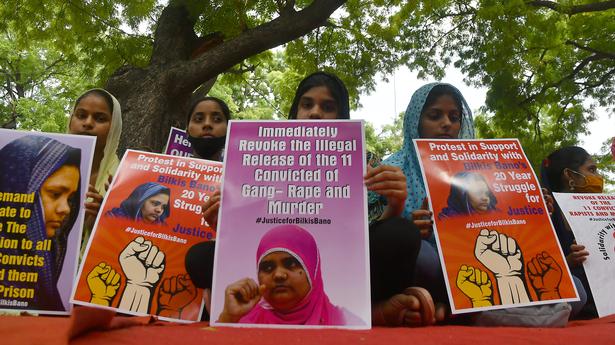Who needs to be consulted before taking a decision on remission? Were the norms followed?
Who needs to be consulted before taking a decision on remission? Were the norms followed?
The story so far: There has been widespread outrage over the premature release of 11 convicts in a case relating to the gangrape of Bilkis Bano and the murder of at least seven persons, including a three-year-old child, as part of the riots in Gujarat in 2002. The decision by the Gujarat government to grant remission of the remainder of their life imprisonment has come under criticism from lawyers, activists and political parties. It is now under challenge in the Supreme Court.
What happened to the woman and her family?
Bilkis Bano is a gang-rape survivor of the 2002 anti-Muslim pogrom in Gujarat. On March 3 that year, Bilkis, who was pregnant, was part of a group moving from one village to another for safety. Rioters brutally attacked them near a village called Pannivel, raped the women and killed many of them, including her three-year-old daughter. The incident left 14 people dead, according to the police, but only seven bodies were found. Neither the girl’s body nor that of a two-day-old infant born to her cousin was found. The Supreme Court transferred the investigation to the CBI and the case to Mumbai to facilitate a free and fair trial. Eleven men were convicted by the trial court and sentenced to life. The Bombay High Court confirmed their life terms in 2017.
How did the 11 men walk out of prison?
Life imprisonment normally means convicts remain in jail for the whole of their life. However, they can be released by the State and Central governments at some point, but not before they complete 14 years, by remitting the remaining prison term. Ramesh Rupabhai, one of the convicts, approached the Bombay High Court in 2013 seeking that his release be considered. However, the court ruled that even though the trial took place in Mumbai, the appropriate government to consider remission was Gujarat. Radheshyam Shah, another accused, approached the Gujarat High Court seeking remission. However, the court ruled that as the trial took place in Maharashtra, the appropriate government would be Maharashtra. On his appeal to the Supreme Court, a two-judge Bench ruled on May 22 this year that Gujarat is the appropriate government to consider remission. Significantly, it also accepted the petitioner’s claim that the remission should be under the 1992 policy that prevailed in Gujarat on the date of his conviction in 2008. Based on the Supreme Court’s direction to consider their plea for remission, the Gujarat government ordered the release of all the 11 convicts, and they walked free on August 15 this year.
What are the rules for remission?
Judicial decisions advocate both subjective and objective norms for remission. Courts have ruled that remission should be informed, fair and reasonable, and not arbitrary; that it should not undermine the nature of the crime.
In Laxman Naskar vs Union of India (2000), the Supreme Court laid down five considerations: whether the offence is an individual act of crime that does not affect society; whether there is a chance of the crime being repeated in future; whether the convict has lost the potentiality to commit crime; whether any purpose is being served in keeping the convict in prison; and socio-economic conditions of the convict’s family.
Was the remission given in this case legal?
The outcry over the remission granted in this case is largely due to the brutal and horrific nature of the crime. However, lawyers and activists have highlighted possible legal infirmities. For one, the remission has been granted by the Gujarat government without consulting the Centre. Under Section 435 of the Code of Criminal Procedure (CrPC), in a case investigated by the CBI, such consultation is mandatory prior to remission. The Supreme Court has also ruled that ‘consultation’ means ‘concurrence’ in this regard.
Further, reports indicate that the committee that recommended remission contained some Bharatiya Janata Party (BJP) functionaries, including two MLAs. A remission panel usually consists of government officials, officers in charge of parole, rehabilitation and probation of offenders and prison officials. The opinion of the judge who conducted the trial or in charge of the district should be taken too.
In this case, the district judge is understood to have opposed the grant of remission. While the judge’s opinion may not be binding, courts have cautioned against brushing aside the opinion without valid reasons. It may also be argued that the presence of political functionaries on the committee may have influenced the decision.
The question whether Gujarat is indeed the appropriate government may also be raised again, even though the order by which the Supreme Court wanted their remission plea to be considered has already given its finding. Section 432(7) of the CrPC says the appropriate government will be “the State within which the offender is sentenced or the said order is passed”.
Editorial | Reviewing remission: On the need for norms to release convicts
Commentators have pointed out that the current remission policy bars those found guilty of heinous crimes from being given remission. Their release under a 1992 policy (because it was the one prevailing on the day of their conviction) may also be subjected to legal scrutiny.
- When one of the convicts in the Bilkis Bano case appealed to the Supreme Court to consider his release, a two-judge Bench ruled on May 22, 2022, that Gujarat is the appropriate government to consider remission. The Bench also accepted the petitioner’s claim that the remission should be under the 1992 policy that prevailed in Gujarat on the date of his conviction in 2008.
- Based on the Supreme Court’s direction to consider their plea for remission, the Gujarat government ordered the release of all the 11 convicts, and they walked free on August 15, 2022.
- The outcry over the remission granted in this case is largely due to the brutal and horrific nature of the crime. However, lawyers and activists have highlighted possible legal infirmities. For one, the remission has been granted by the Gujarat government without consulting the Centre. Further, reports indicate that the committee that recommended remission contained some BJP functionaries, including two MLAs





